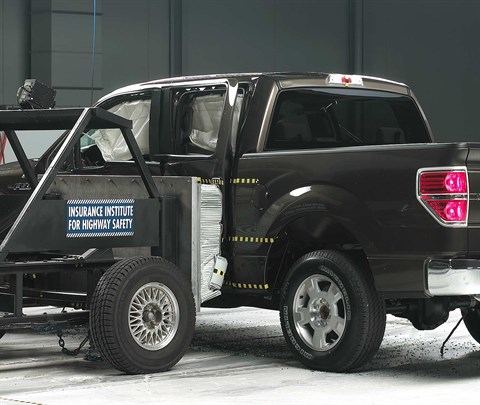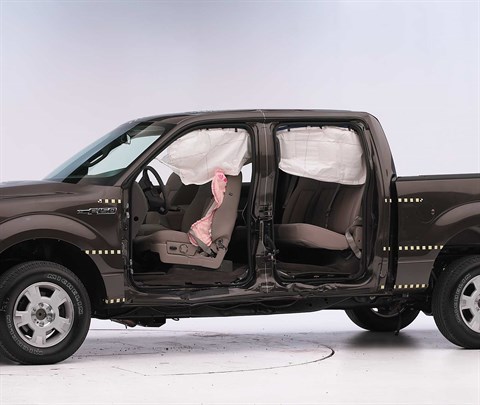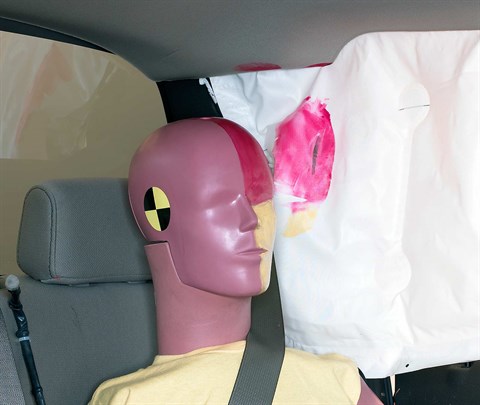Moderate overlap front: original test
Rating applies to 2009-14 models
Tested vehicle: 2009 Ford F-150 XL SuperCrew
The Ford F-150 was redesigned for the 2009 model year. Frontal ratings are assigned by the Institute based on a test conducted by Ford.
| Evaluation criteria | Rating |
|---|---|
| Overall evaluation | |
| Structure and safety cage | |
| Driver injury measures | |
| Head/neck | |
| Chest | |
| Leg/foot, left | |
| Leg/foot, right | |
| Driver restraints and dummy kinematics | |
Measures of occupant compartment intrusion on driver side
| Evaluation criteria | Measurement |
|---|---|
| Test ID | VTF0817 |
| Footwell intrusion | |
| Footrest (cm) | 12 |
| Left (cm) | 13 |
| Center (cm) | 17 |
| Right (cm) | 9 |
| Brake pedal (cm) | 14 |
| Instrument panel rearward movement | |
| Left (cm) | 4 |
| Right (cm) | 4 |
| Steering column movement | |
| Upward (cm) | -4 |
| Rearward (cm) | 0 |
| A-pillar rearward movement (cm) | 1 |
Driver injury measures
| Evaluation criteria | Measurement |
|---|---|
| Test ID | VTF0817 |
| Head | |
| HIC-15 | 245 |
| Peak gs at hard contact | no contact |
| Neck | |
| Tension (kN) | 0.6 |
| Extension bending moment (Nm) | 8 |
| Maximum Nij | 0.19 |
| Chest maximum compression (mm) | 29 |
| Legs | |
| Femur force - left (kN) | 2.7 |
| Femur force - right (kN) | 0.8 |
| Knee displacement - left (mm) | 4 |
| Knee displacement - right (mm) | 0 |
| Maximum tibia index - left | 0.75 |
| Maximum tibia index - right | 0.31 |
| Tibia axial force - left (kN) | 5.8 |
| Tibia axial force - right (kN) | 4.2 |
| Foot acceleration (g) | |
| Left | 152 |
| Right | 79 |
Side: original test
Rating applies to 2009-14 models
Tested vehicle: 2009 Ford F-150 XLT SuperCrew with standard front and rear head curtain airbags and standard front seat-mounted torso airbags
The Ford F-150 was redesigned for the 2009 model year.
| Evaluation criteria | Rating |
|---|---|
| Overall evaluation | |
| Structure and safety cage | |
| Driver injury measures | |
| Head/neck | |
| Torso | |
| Pelvis/leg | |
| Driver head protection | |
| Rear passenger injury measures | |
| Head/neck | |
| Torso | |
| Pelvis/leg | |
| Rear passenger head protection | |

View of the vehicle and barrier just after the crash test.

View of the vehicle after the crash with doors removed, showing the side airbags and damage to the occupant compartment.

Smeared greasepaint shows where the driver dummy's head was protected from being hit by hard structures by the side airbags.

Smeared greasepaint shows where the rear passenger dummy’s head was protected by the side airbag.
Measures of occupant compartment intrusion on driver side
| Test ID | CES0850 |
|---|---|
| B-pillar to longitudinal centerline of driver's seat (cm) | -16.0 |
| Negative numbers indicate the amount by which the crush stopped short of the seat centerline. | |
Driver injury measures
| Evaluation criteria | Measurement |
|---|---|
| Test ID | CES0850 |
| Head HIC-15 | 263 |
| Neck | |
| Tension (kN) | 2.0 |
| Compression (kN) | 0.3 |
| Shoulder | |
| Lateral deflection (mm) | 43 |
| Lateral force (kN) | 1.7 |
| Torso | |
| Maximum deflection (mm) | 35 |
| Average deflection (mm) | 32 |
| Maximum deflection rate (m/s) | 3.04 |
| Maximum viscous criterion (m/s) | 0.54 |
| Pelvis | |
| Iliac force (kN) | 2.2 |
| Acetabulum force (kN) | 2.4 |
| Combined force (kN) | 4.5 |
| Left femur | |
| L-M force (kN) | 0.4 |
| L-M moment (Nm) | 88 |
| A-P moment (Nm) | -34 |
Passenger injury measures
| Evaluation criteria | Measurement |
|---|---|
| Test ID | CES0850 |
| Head HIC-15 | 57 |
| Neck | |
| Tension (kN) | 0.1 |
| Compression (kN) | 0.4 |
| Shoulder | |
| Lateral deflection (mm) | 14 |
| Lateral force (kN) | 0.3 |
| Torso | |
| Maximum deflection (mm) | 29 |
| Average deflection (mm) | 19 |
| Maximum deflection rate (m/s) | 3.44 |
| Maximum viscous criterion (m/s) | 0.26 |
| Pelvis | |
| Iliac force (kN) | 0.5 |
| Acetabulum force (kN) | 0.8 |
| Combined force (kN) | 1.1 |
| Left femur | |
| L-M force (kN) | 0.5 |
| L-M moment (Nm) | 83 |
| A-P moment (Nm) | -32 |
Roof strength
Rating applies to 2011-14 models built after February 2011
Tested vehicle: 2011 Ford F-150 XLT SuperCrew
| Overall evaluation | |
|---|---|
| Curb weight | 5,342 lbs |
| Peak force | 25,234 lbs |
| Strength-to-weight ratio | 4.72 |
Head restraints & seats
Seat type: Manual cloth seats
| Overall evaluation | |
|---|---|
| Dynamic rating | |
| Seat/head restraint geometry |
| Seat type | Manual cloth seats |
|---|---|
| Geometry | |
| Backset (mm) | 20 |
| Distance below top of head (mm) | 8 |
| Seat design parameters | |
| Pass/fail | Pass |
| Max T1 acceleration (g) | 12.8 |
| Head contact time (ms) | 54 |
| Force rating | 1 |
| Neck forces | |
| Max neck shear force (N) | 26 |
| Max neck tension (N) | 530 |
About the head restraint & seat test
Currently, IIHS tests apply only to front seats.
